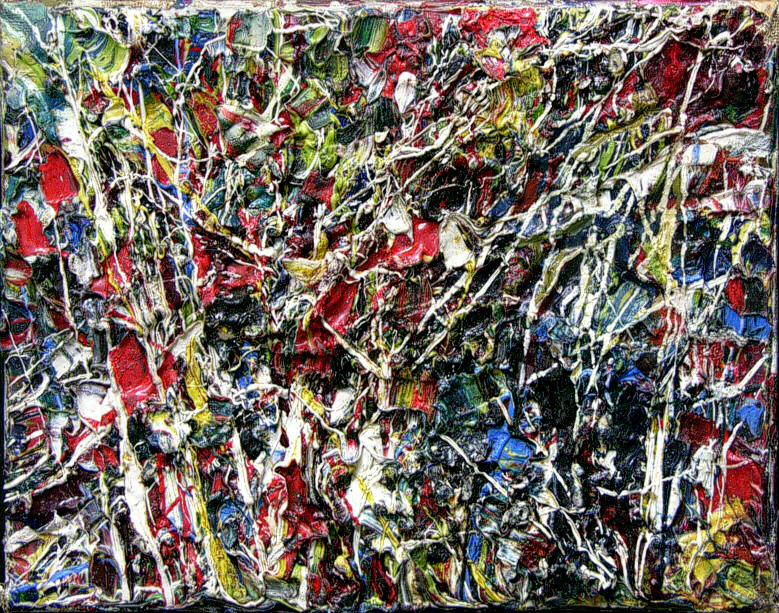Sans titre
Oil on canvas, 1950
19 x 24 centimeters
7.5 x 9.5 inches.
Provenance
Maurice Lefebvre-Foinet, Paris.
Art Impressionniste et Modern, lot 49, December 1st. 2009, Christies, Paris.
Illustrated Reference
- P. Schneider, Riopelle signes meles, Paris, 1972, no. 26, p. 19, illustrated in color.
- D. Craven, The automatist paintings of Jean-Paul Riopelle, artscanada, Toronto, Mar/Apr 1981, p. 48, illustrated.
- Y. Riopelle, Jean-Paul Riopelle Catalogue Raisonne 1939-1953, Montreal, 1999, vol. I, no. 1950.019H.1950, p. 234, illustrated in color.
Born in Montreal, Jean Paul Riopelle began drawing lessons in 1933 and continued through 1938. He studied engineering, architecture and photography at the Ecole polytechnique in 1941. In 1942 he enrolled at the Ecole des beaux-arts de Montreal but shifted his studies to the less academic Ecole du Meuble, graduating in 1945.
Jean Paul Riopelle studied under Paul-Emile Borduas in the 1940s and was a member of Les Automatistes movement. Braking with traditional conventions in 1945 after reading Breton’s Le Surrealisme et la Peinture, he began experimenting with non-objective (or non-representational) painting. He was one of the signers of the Refus global manifesto. In 1947 Riopelle moved to Paris and continued his career as an artist, where, after a briefly association with the surrealists (he was the only Canadian to have exhibit with them) he capitalized on his image as a “wild Canadian”. His first solo exhibition took place in 1949 at the Surrealist meeting place, Galerie La Dragonne in Paris.
In 1959 he began a relationship with the American painter Joan Mitchell.[4] Living together throughout the 1960s, they kept separate homes and studios near Giverny, where Monet had lived. They influenced one another greatly, as much intellectually as artistically, but their relationship was a stormy one, fueled by alcohol. The relationship ended in 1979. His 1992 painting Hommage Rosa Luxemburg is Riopelle’s tribute to Mitchell, who died that year, and is regarded as a high point of his later work.
Jean Paul Riopelle’s style in the 1940s changed quickly from Surrealism to Lyrical Abstraction, in which he used myriad tumultuous cubes and triangles of multicolored elements, facetted with a palette knife, spatula, or trowel, on often large canvases to create powerful atmospheres.
The presence of long filaments of paint in his painting from 1948 through the early 1950s has often been seen as resulting from a dripping technique like that of Jackson Pollock. Rather, the creation of such effects came from the act of throwing, with a palette knife or brush, large quantities of paint onto the stretched canvas.
Riopelle’s voluminous impasto became just as important as color. His oil painting technique allowed him to paint thick layers, producing peaks and troughs as copious amounts of paint were applied to the surface of the canvas. Riopelle, though, claimed that the heavy impasto was unintentional: “When I begin a painting,” he said, “I always hope to complete it in a few strokes, starting with the first colours I daub down anywhere and anyhow. But it never works, so I add more, without realizing it. I have never wanted to paint thickly, paint tubes are much too expensive. But one way ar another, the painting has to be done. When I learn how to paint better, I will paint less thickly.”
When Jean Paul Riopelle started painting, he would attempt to finish the work in one session, preparing all the color he needed before hand: “I would even go as far to say obviously I don’t use a palette, but the idea of a palette or a selection of colors that is not mine makes me uncomfortable, because when I work, I can’t waste my time searching for them. It has to work right away.”
A third element, range of gloss, in addition to color and volume, plays a crucial role in Riopelle’s oil paintings. Paints are juxtaposed so that light is reflected off the surface not just in different directions but with varying intensity, depending on the naturally occurring gloss finish (he did not varnish his paintings). These three elements; color, volume, and range of gloss, would form the basis of his oil painting technique throughout his long and prolific career.
Riopelle received an Honorable Mention at the 1952 SAO Paulo Art Biennial and would later represent Canada at the Venice Biennale in 1962. In 1953 he showed at the Younger European Painters exhibition at the Solomon R. Guggenheim Museum in New York City. The following year Riopelle began exhibiting at the Pierre Matisse Gallery in New York. Riopelle received an Honorable Mention at the Guggenheim Museums Guggenheim International Award exhibition in 1958 and a major retrospective of his work was held at the Kelnischer Kunstverein, Cologne. Subsequent retrospectives of Riopelles work were held at the National Gallery of Canada in 1963, a smaller exhibition at the Musee du Quebec in 1967, at the Fondation Maeght (Saint Paul-de-Vence, France) in 1971, and at the Musee d Art Moderne de la Ville de Paris in 1972. Courtesy Wikipedia
Automatiste Group: It was under Borduas direction that Riopelle made his first abstract painting. Borduas and several of his students, including Riopelle, formed a group that worked, socialized and exhibited together 1942-45. The group became known as the Automatistes for their spontaneous method of painting, which drew on the subconscious as a source. In 1946 Riopelle first travelled to France, where he would return and settle the following year. In 1948 Borduas authored the manifesto Refus global, which was signed by a number of his students, including Riopelle.
The images and content accessible on this site are protected under international copyright law
and may not be used for any manner of publication or transmitted, in whole or in part, over
communication networks without written permission from the copyright holders.

